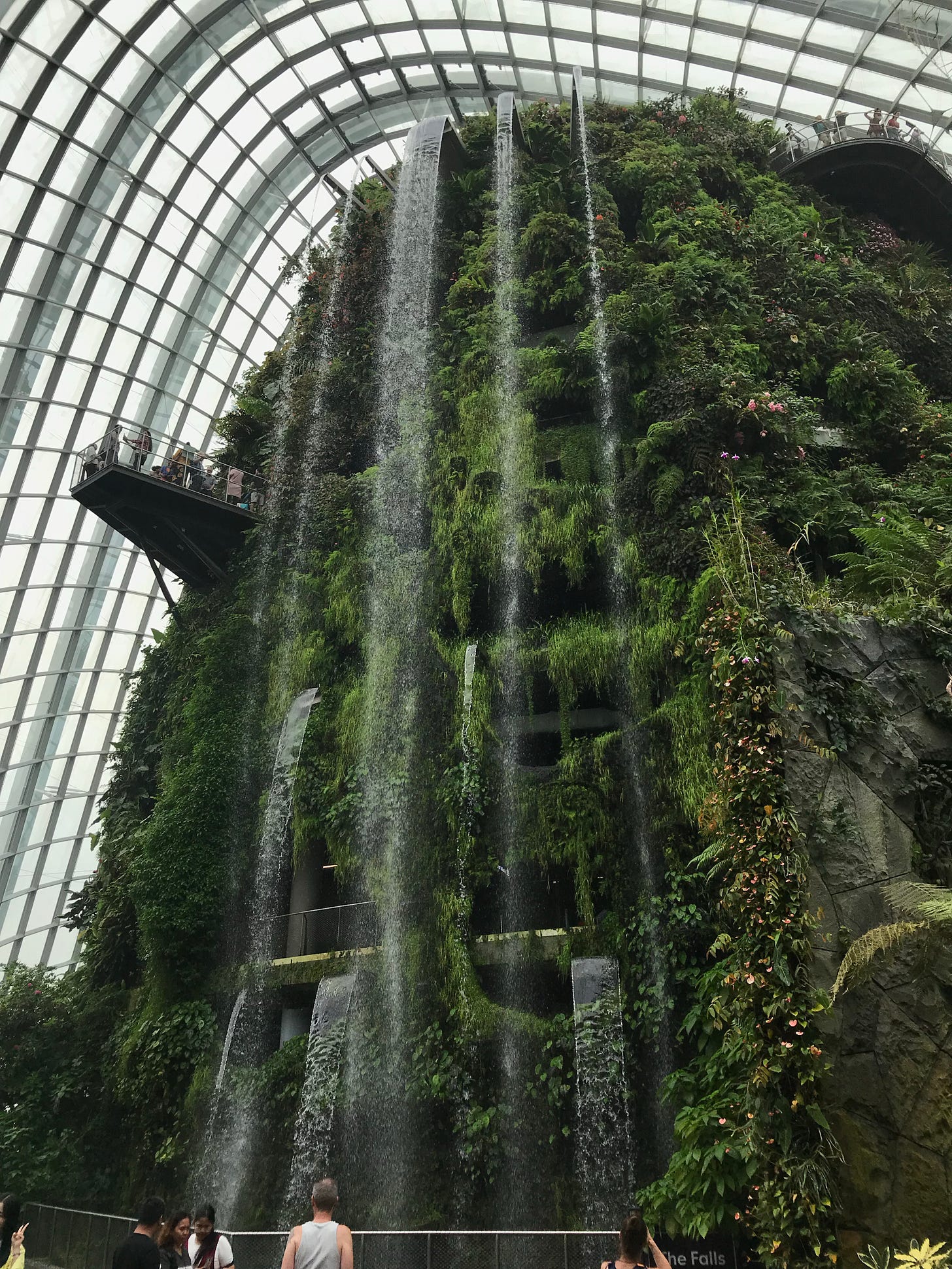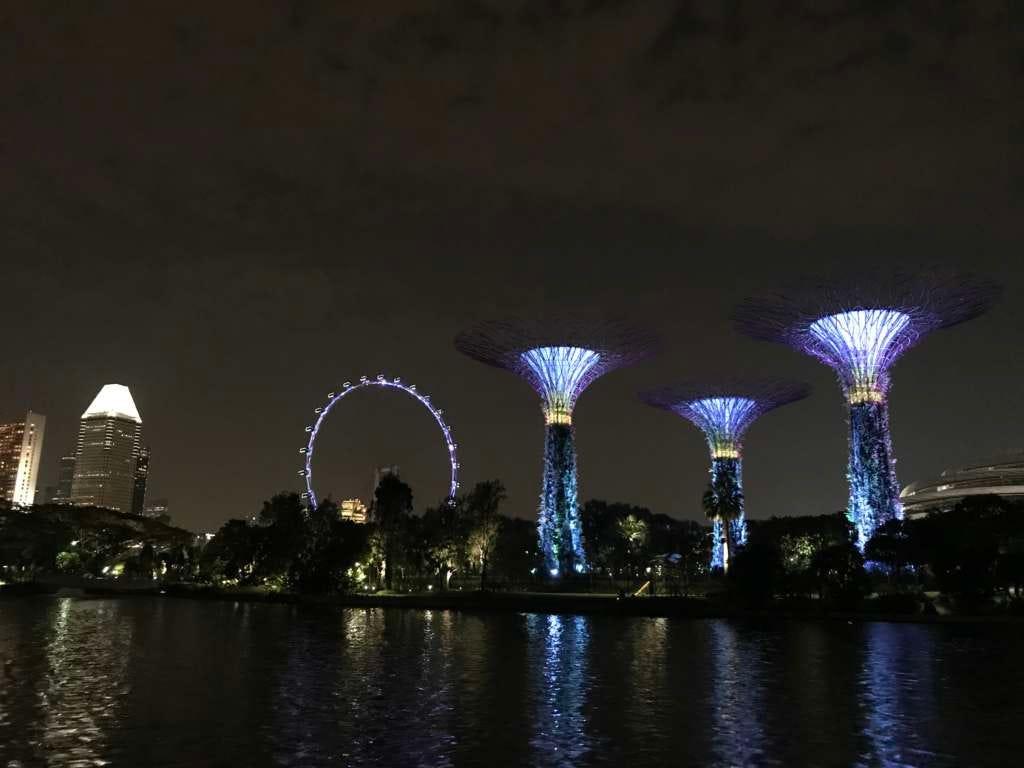Singapore

Phil Rosen

The air was heavy and humid when I first arrived in Singapore. I had incorrectly assumed that late-winter would have been a temperate, mild season to visit the only city-state in Asia. Singapore keeps its humidity dialed up year-round due to its frequent rainfall and proximity to the equator.
I was glad to have landed on the 18-mile-long island after my four-hour flight from Hong Kong.
(I note here the four-hour duration not to complain of its length — I slept like a satiated koala anyway — but only to interpose that the world’s longest commercial flight is from Singapore to Newark, New Jersey. Besides Hong Kong being several notches higher than Newark on the coolness scale that I’ve just now invented, I lucked out doubly because my flight lasted but a fraction of the time of a Singapore-bound Newarkian. I digress.)
Like most cities, the first place you walk through when you get off the plane is the airport. Singapore’s Changi Airport has won innumerable awards for its quality, efficiency, and simply for how awesome it is.
With billions of dollars worth of renovations and attractions, Changi has created the new standard for what an airport could and should be. The airport boasts a high-class movie theatre, swimming pool, and spectacular indoor waterfall. In addition to those coming and going from Singapore, many non-traveling patrons frequent the airport, giving it a bit of a locals’ stamp of approval.
Getting through immigrations took less than ten minutes and everything was done without touch — cameras, passport scanners, and automatic glass doors opened without so much as a hum. Coming directly from Hong Kong, I was already accustomed to swiftness in the public sector — both the public transportation and airport in Hong Kong are first-rate in terms of efficiency.
Nonetheless, the pace of things in Singapore impressed me. Here, people walk quickly and cars change lanes at an uncomfortably fast clip. The Mass Rapid Transit (MRT) runs like a Swiss watch (or perhaps it is actually Swiss watches that run like the MRT).
Dubbed the “Lion City," as well as the “melting pot” of Southeast Asia, Singapore left its mark on me most distinctly with its level of cleanliness. Never have I strolled through a city and seen so few items of litter (after five days of keeping a wary eye out for garbage on the floor, my running total remained at zero).
The immaculate roads, scrubbed windows, and dutiful citizens can be explained in large part by a set of Draconian laws that polices public behavior and ensures cleanliness. Memorable dictums include a strict no-bubblegum law, pervasive anti-smoking policy, and varying, lofty fines for public drunkenness, singing rude song lyrics, or even playing music in public.
There is a looming threat of jail-time for obscure actions like obstructing someone’s path while they are walking (and Singaporeans walk very fast) as well as more severe punishments for publishing content that could pass as anti-government.
A major divergence from the West lay in the Singaporean governments’ pseudo-ownership of the media. Like Big Brother, the Singaporean government determines what disseminates and what does not. Independent voices seeking platform are often stymied, silenced, or otherwise convinced to keep their opinions to themselves.
With these preconditions in mind, I nonetheless found myself cautiously admiring the cleanliness, safety, and general upkeep of the metropolis. The city has one of the lowest crime rates in the world (it is as close to zero as it gets). The citizens seemed far more scrupulous and urbane than Americans or Brits, though I’m not sure if their peace of mind reflects this.
As a Westerner and a writer, tolerating politically-motivated censorship in exchange for cleaner sidewalks hardly sounds like a fair shake. Like all things, living within specified parameters of an authoritarian government has its disadvantages and trade-offs.
Singapore is packed with stuff—skyscrapers, sightseeing, museums, harbors—and is one of the top five most densely populated places in the world. Granted the geography is limited in terms of overall space (about 279 square miles), nonetheless the population is packed tight and rising still.
Viewed from any angle or height, the skyline overflows with architecture to such an extent that if one more building were to be constructed the entire island may just sink into the ocean and leave the tip of a Malaysia with but a gaping, Singapore-sized crater. (I took the photo below from the top of Marina Bay Sands Observation Deck).
And yet, in spite of the overwhelming amount of buildings and people, the feeling I felt walking around the city was not one of claustrophobia or suffocation but rather one of detachment.
Things in Singapore are masterfully constructed, ornate, and colorful; but when viewed individually, each object I observed appeared a bit too artificial, too pristine, too man-made.
Singapore holds all the modernity and glamor of the future but, in my eyes, remains eerily devoid of natural happenings, like a physical body without a soul. This sense of artificiality followed me through the city; the cleanliness I had at first admired now seemed antiseptic and sanitized like a brand-new hospital.
A large proportion of my time in Singapore felt as if I was walking through a giant museum of artifacts from the future rather than a teeming, breathing nation.
The Gardens by the Bay proved to be the exception — sweeping expanses of greenery, verdant forests, and several disparate “habitats” all located in the middle of the concrete jungle that is Singapore. Walking through the Gardens by the Bay is free and very popular. It is the highest ranked tourist attraction in Singapore, though the two observatories — the Cloud Forest and the Flower Dome — together cost about $20.00 USD.
Widely popularized by the 2018 movie, Crazy Rich Asians, the picturesque Gardens by the Bay is breathtaking. The indoor waterfall — purported to be the world’s tallest —in the Cloud Forest is loud and thundering and magnificent, and flows directly out of a towering indoor mountain lush with exotic plants. The exhibit seemed to be taken directly from the dream of a mad-scientist turned botanist.
I stood at the bottom of the waterfall and lost track of time staring upwards at the waterfall and the glass ceiling of the dome-shaped greenhouse. I only awoke from my reveries when I became conscious of the soreness in my upper back caused by craning my neck for so long.
The Gardens by the Bay made for an altogether leisurely afternoon (the Flower Dome was pleasant though not quite as awe-inspiring as the Cloud Forest). I was advised by an exhibit employee to return after sunset to view the SuperTrees light show.
The SuperTrees are giant and futuristic amalgams of steel and plants, adorned top to bottom with high-tech miniature light bulbs. Standing tall as skyscrapers and covered in wiry, aesthetic branches, they appeared to be something from James Cameron’s Avatar.
I showed up around 7:45PM for the 8PM light show and sat on the ground alongside hundreds of eager tourists. It runs twice per evening, every single day of the year. I did not know what to expect, though I noticed that every individual within my vicinity had cameras at the ready.
Up until the light show, I had enjoyed my time touring Singapore but felt lukewarm about my trip. I liked much of what I had seen up to that point, but at the same time I had traveled to a dozen countries in Asia before Singapore. I was beginning to grow jaded with some of the recurring themes of my travels.
The food was similar to other destinations I’d recently visited. I heard far more of my mother-tongue Cantonese than I expected (Singapore has four official languages: Malay, Mandarin Chinese, Tamil, English). The skyscrapers seemed less impressive than they otherwise would be because I had just come from Hong Kong.
But then the light show began.
The sky above was dark. The glow of the SuperTrees became the only visible items. They emitted a stunning, surreal display of lights that danced in sync with orchestral music that played from speakers installed in the very floor itself. Grand and epic songs played to accompany the lights that flickered, sparkled, and waltzed to perfection.
It was not merely a light show: it was an arresting, choreographed dance performed by a system of computers and wiring that left the audience in a silent trance up until the closing seconds. The effect was otherworldly, metaphysical even.
The audience, myself included, clapped so eagerly and loudly that I nearly forgot we were clapping for a system of machines. These cold and artificial machines had touched a human fiber, and in turn we were showing our appreciation. Collectively we had momentarily dismissed the notion that we were applauding inanimate objects.
It was one of the most magical episodes of my lifetime. Never before had I had such a visceral reaction to a visual display.
Within the span of a 15-minute light show, Singapore skyrocketed up my list of favorite destinations in Asia.
Singapore in many ways represents the future of humanity itself: a land dominated by technology, towering man-made structures, and steel contraptions that replicate objects from nature. Crime, litter, and political dissent are nearly non-existent, but only as a consequence of the authoritarian underpinnings of the system. Public transportation and air travel are elite in both regulation and luxury — the only thing missing from the bells and whistles of this futuristic city seems to be the flying cars of The Jetsons.
When I reflect on my short stay in Singapore, I remember it as a destination worth visiting, a charmingly small geographical alcove that prides itself on its majestic architecture, technology, and even diversity of peoples.
In particular, I think back to the SuperTrees often and fondly. These thoughts remind me that I need to return to Singapore in the near future, even if only to replicate that strange and mystical feeling imparted by the light show (media censorship laws notwithstanding).
Overall, it was a brilliant trip. Without a doubt I will be back.




